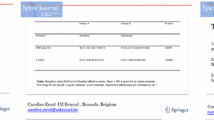Abstract
The study aims were to estimate the radiation dose in patients examined with low dose spine CT and to compare it with that received by patients undergoing standard CT for trauma of the same region, as well as to evaluate the impact of dose reduction on image quality. Radiation doses in 113 consecutive low dose spine CTs were compared with those in 127 CTs for trauma. The inter- and intraobserver agreement in measurements of pedicular width, and vertebral rotation, measurements of signal-to-noise ratio and assessment of hardware status were the indicators in the evaluation of image quality. The effective dose of the low dose spine CT (0.37 mSv) was 20 times lower than that of a standard CT for trauma (13.09 mSv). This dose reduction conveyed no impact on image quality. This low dose spine CT protocol allows detailed evaluation that is necessary for preoperative planning and postoperative evaluation.


Similar content being viewed by others
References
Leatherman KD, Dickson RA (1988) The management of spinal deformities. Wright, London
Perdriolle R, Vidal J (1985) Thoracic idiopathic scoliosis curve evolution and prognosis. Spine 10(9):785–791
Weinstein SL, Ponseti IV (1983) Curve progression in idiopathic scoliosis. J Bone Joint Surg Am 65(4):447–455
Maiocco B, Deeney VF, Coulon R, Parks PF Jr (1997) Adolescent idiopathic scoliosis and the presence of spinal cord abnormalities. Preoperative magnetic resonance imaging analysis. Spine 22(21):2537–2541
Benli IT, Un A, Karaaslan S, Cinemre O, Gurses L, Hekimoglu B (2002) Neural axis abnormalities detected by preoperative magnetic resonance imaging in patients with type III idiopathic scoliosis. Acta Orthop Traumatol Turc 36(4):354–361
Winter RB, Lonstein JE, Heithoff KB, Kirkham JA (1997) Magnetic resonance imaging evaluation of the adolescent patient with idiopathic scoliosis before spinal instrumentation and fusion. A prospective, double-blinded study of 140 patients. Spine 22(8):855–858
Barnes PD, Brody JD, Jaramillo D, Akbar JU, Emans JB (1993) Atypical idiopathic scoliosis: MR imaging evaluation. Radiology 186:247–253
Abul-Kasim K, Gunnarsson M, Maly P, Ohlin A, Sundgren PC (2008) Radiation dose optimization in CT planning of corrective scoliosis surgery. A phantom study. Neuroradiol J 21:374–382
SIEMENS. SOMATOM Sensation 64, Application Guide (2004) Siemens AG medical solution, computed tomography, pp 29–32
Bongartz G, Golding SJ, Jurik AG, Leonardi M, van Persijn van Meerten E, Rodríguez R, Schneider K, Calzado A, Geleijns J, Jessen KA, Panzer W, Shrimpton PC, Tosi G (2004) European guidelines for multislice computed tomography. Funded by the European Commission. Contract number FIGM-CT2000–20078-CT-TIP; March 2004
The Working Group on 3-D Classification (Chair Larry Lenke) and the Terminology Committee (March 2000). Scoliosis Research Society Terminology Committee and Working Group on Spinal Classification, Revised Glossary of Terms. Available via: http://www.srs.org/professionals/glossary/glossary.php. Accessed 17 April 2008
Aaro S, Dahlborn M, Svensson L (1978) Estimation of vertebral rotation in structural scoliosis by computer tomography. Act Radiol Diagn 19(6):990–992
Landis JR, Koch GG (1977) The measurement of observer agreement for categorical data. Biometrics 33(1):159–174
Landis JR, Koch GG (1977) An application of hierarchical kappa-type statistics in the assessment of majority agreement among multiple observers. Biometrics 33(2):363–374
Viera AJ, Garrett JM (2005) Understanding interobserver agreement: the kappa statistic. Fam Med 37(5):360–363
Garson GD (2008) Reliability analysis. Available via: http://www2.chass.ncsu.edu/garson/pa765/reliab.htm. Accessed 17 April 2008
Ho E, Upadhyay SS, Chan FL, Hsu LC, Leong JC (1993) New methods of measuring vertebral rotation from computed tomographic scans. Spine 18(9):1173–1177
Krismer M, Sterzinger W, Haid C (1996) Axial rotation measurement of scoliotic vertebrae by means of CT scans. Spine 21(5):576–581
Göçen S, Havitçioğlu H, Alici E (1999) A new method to measure vertebral rotation from CT scan. Eur Spine J 8(4):261–265
Krismer M, Chen AM, Steinlechner M, Haid C, Lener N, Wimmer C (1999) Measurement of vertebral rotation: a comparison of two methods based on CT scan. J Spinal Disord 12(2):126–130
Göçen S, Aksu MG, Baktiroğlu L, Özcan Ö (1998) Evaluation of computed tomographic methods to measure vertebral rotation in adolescent idiopathic scoliosis: an intraobserver and interobserver analysis. J Spinal Disord 11(3):210–214
Vande Berg B, Malghem J, Maldague B, Lecouvet F (2006) Multi-detector CT imaging in the postoperative orthopedic patient with metal hardware. Eur J Radiol 60(3):470–479
Wintermark M, Mouhsine E, Theumann N, Mordasini P, van Melle G, Leyvraz PF, Schnyder P (2003) Thoracolumbar spine fractures in patients who have sustained severe trauma: depiction with multi-detector row CT. Radiology 227(3):681–689
Nishizawa K, Matsumoto M, Iwai K, Tonari A, Yoshida T, Takayama M (2002) Dose evaluation and effective dose estimation from multi detector CT. Igaku Butsuri 22(3):152–158
Tsapaki V, Aldrich JE, Sharma R, Staniszewska MA, Krisanachinda A, Rehani M, Hufton A, Triantopoulou C, Maniatis PN, Papailiou J, Prokop M (2006) Dose reduction in CT while maintaining diagnostic confidence: diagnostic reference levels at routine head, chest, and abdominal CT-IAEA-coordinated research project. Radiology 240(3):828–834
Mulkens TH, Bellinck P, Baeyaert M, Ghysen D, Van Dijck X, Mussen E, Venstermans C, Termote JL (2005) Use of an automatic exposure control mechanism for dose optimization in multi-detector row CT examinations: clinical evaluation. Radiology 237:213–223
Brenner DJ, Hall EJ (2007) Computed tomography-an increasing source of radiation exposure. N Engl J Med 357(22):2277–2284
Royal College of Radiologists (1998) Making the best use of department of clinical radiology: Guidelines for doctors, 4th edn. Royal College of Radiologists, London
Åkerblom G, Falk R, Lindgren J, Mjönes L, Östergren I, Söderman A-L et al (2005) Natural radioactivity in Sweden, exposure to internal radiation. Radiological protection in transition, Proceedings of the XIV Regular Meeting of the Nordic Society for Radiation Protection. NSFS. Rättvik, Sweden, 27–31 August 2005. pp 211–214. Given as SSI-report SSI 2005:15
Author information
Authors and Affiliations
Corresponding author
Rights and permissions
About this article
Cite this article
Abul-Kasim, K., Overgaard, A., Maly, P. et al. Low-dose helical computed tomography (CT) in the perioperative workup of adolescent idiopathic scoliosis. Eur Radiol 19, 610–618 (2009). https://doi.org/10.1007/s00330-008-1178-4
Received:
Accepted:
Published:
Issue Date:
DOI: https://doi.org/10.1007/s00330-008-1178-4




